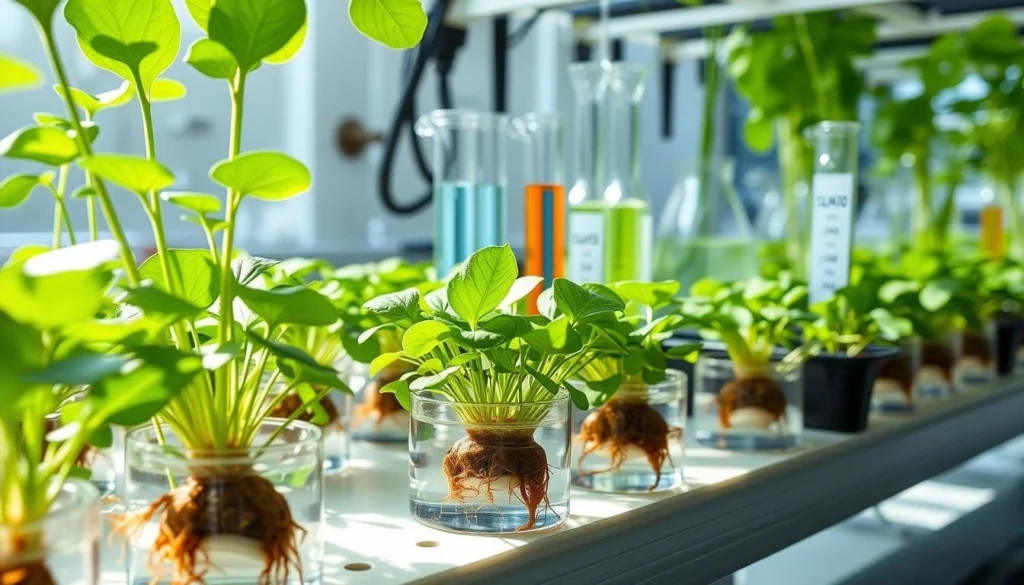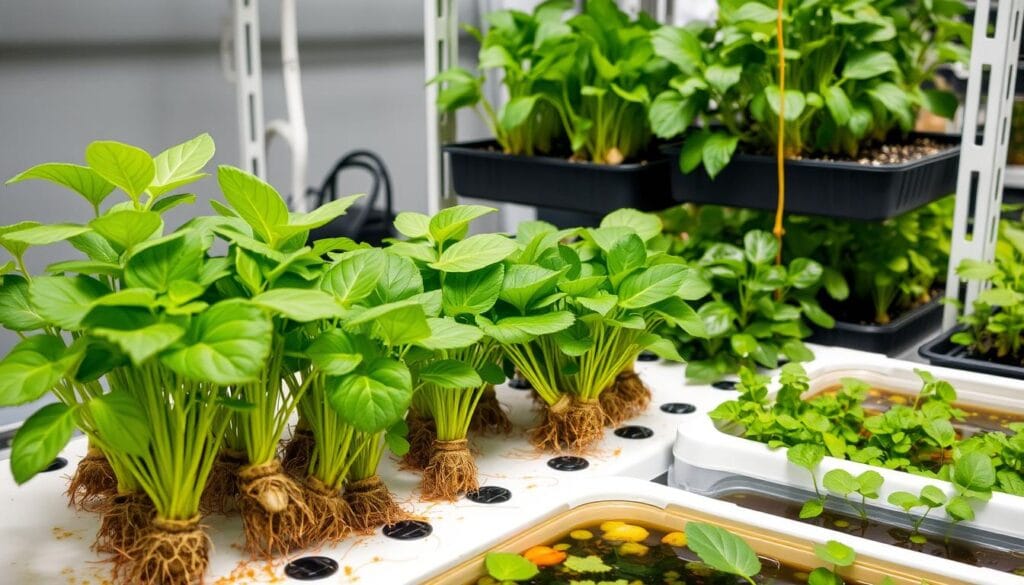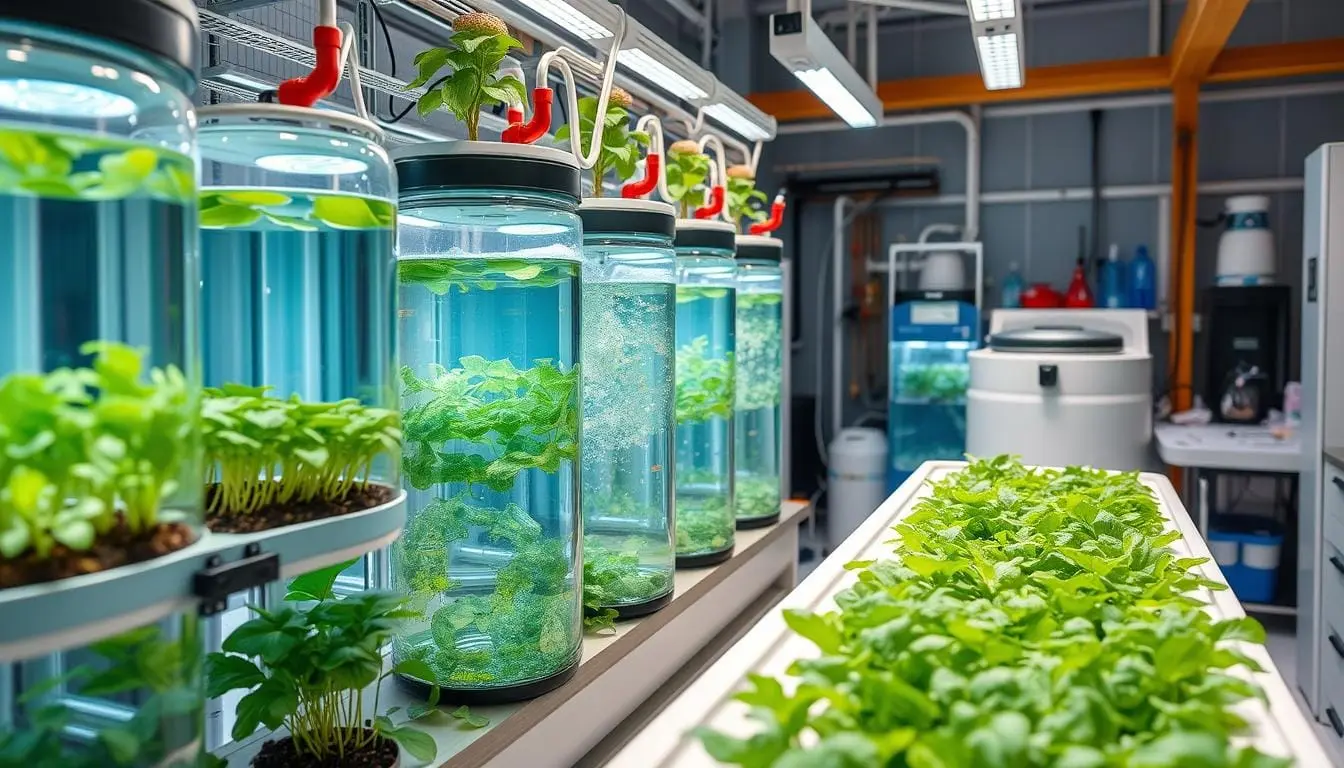The first time I realized the critical importance of managing heavy metals in hydroponic systems, I was staring at my struggling plants. I wondered why they weren’t thriving. Like many hydroponic enthusiasts, I found out that water contamination can silently harm your growing operation. Heavy metals in general hydroponics are not just a minor concern – they’re a disaster waiting to happen.
Managing water quality is key for successful plant nutrition. Your hydroponic system’s success depends on understanding and fighting metal contamination risks. The stakes are high – your plants’ health, crop yield, and investment are all at risk.
Innovative hydroponic growers are now using advanced strategies to fight heavy metal challenges. By focusing on precise water management and advanced filtration, you can create a safer, more productive growing environment.
Key Takeaways
- Heavy metals can severely impact plant growth and nutrient absorption
- Regular water testing is essential for hydroponic system health
- Advanced filtration technologies can significantly reduce metal contamination
- Proper nutrient solution management prevents metal accumulation
- Proactive monitoring is key to maintaining optimal plant nutrition
Understanding Heavy Metals in Hydroponic Systems
Hydroponic farming is a new way to grow food that’s safer and better for the planet. It’s important to watch out for heavy metals in these systems. Heavy metals can harm plants and affect how much food we get.
Heavy metals can get into hydroponic systems in many ways. This can be bad for plants and the people who eat them. Knowing where these metals come from is key to keeping hydroponics safe and effective.
Common Sources of Metal Contamination
- Water supply with mineral impurities
- Nutrient solution components
- Growing media materials
- Equipment and infrastructure degradation
Impact on Plant Growth and Health
Heavy metals can mess up how plants grow. Studies show that too much of certain metals can:
- Lower how well plants make food from sunlight
- They hinder the ability of plants to absorb nutrients.
- Damage plant cells
- Stop plants from growing big
“The presence of heavy metals in a hydroponic system can transform an otherwise promising setup into a serious health risk.” – Agricultural Research Institute”.
Environmental Concerns
Heavy metals can harm more than just plants. They can get into water and hurt other plants and animals. Lead and cadmium are the biggest problems in farming.
But, hydroponic veggies have less heavy metals than regular farm produce. Hydroponics have a lower risk of pollution and health problems. This makes hydroponics a good choice for the environment and our health.
The Science Behind Metal Accumulation in Hydroponic Solutions
It’s key to know how metals build up in hydroponic solutions for good farming and nutrient use. Plants deal with metals in complex ways. This affects water quality and how well crops grow.
Metal absorption in hydroponic systems happens in a few main ways:
- Ion Exchange: Plants swap ions with the nutrient solution
- Adsorption: Metal particles stick to plant roots
- Precipitation: Chemical reactions make metal particles settle
Many things affect how metals are taken up in hydroponics:
- The pH of the nutrient solution
- Water temperature
- Presence of organic matter
- Activity of microbes in the root zone
“Approximately 800 hyperaccumulator species have been identified, the majority of which are nickel hyperaccumulators.”
Plants have clever ways to handle metals. They use sequestration, exclusion, and chelation to avoid metal harm. Organic acids like malate, citrate, and oxalate are key in cleaning up metals.
Knowing these science facts helps hydroponic farmers. They can then find better ways to reduce metal buildup. This keeps crops healthy and of high quality.
Water Quality Management for Metal Reduction
Managing water quality is key for sustainable farming. It helps reduce water contamination in hydroponic systems. The right water filtration can lower heavy metal risks and keep plants healthy.
First, understand your water source. Each type has its own challenges:
- Municipal water often contains chlorine and chloramine
- Well water may have high mineral concentrations
- Rainwater can be naturally soft but potentially acidic
- Surface water might contain organic pollutants
Filtration Systems and Their Efficiency
Choosing the right filtration system is critical. It helps remove contaminants. Advanced methods can greatly improve water quality and plant nutrition.
| Filtration Method | Contaminant Removal | Efficiency Rate |
|---|---|---|
| Sediment Filters | Particles and Debris | 85-90% |
| Carbon Filters | Chlorine and Organic Compounds | 90-95% |
| Reverse Osmosis | Heavy Metals and Dissolved Solids | 95-99% |
Reverse Osmosis Technology
Reverse osmosis is an advanced method for purifying water. It pushes water through a semipermeable membrane. This method removes up to 99% of dissolved solids, including heavy metals.
“Clean water is the foundation of successful hydroponic cultivation” – Hydroponic Research Institute
Regular Water Testing Protocols
Regular water testing is vital. It helps monitor for contamination. Here’s a suggested testing schedule:
- Monthly complete water analysis
- Quarterly heavy metal screening
- Annual detailed environmental impact assessment
By focusing on water quality management, you safeguard your hydroponic system. This approach also encourages sustainable farming techniques.
Heavy Metals in General Hydroponics

Understanding heavy metals is key when it comes to plant nutrition in hydroponics. General Hydroponics has created nutrient solutions with low metal contamination. This ensures high-quality crops.
Products like FloraNova and Maxibloom are tested thoroughly. They exhibit minimal concentrations of heavy metals. This gives growers confidence in their plant nutrition plans.
“High-quality nutrient solutions are essential for successful hydroponic farming.” – Hydroponic Experts”.
Managing heavy metals in hydroponics involves several steps:
- Choosing high-quality salt formulations
- Deciding between liquid or dry nutrient solutions
- Regularly checking metal content
- Knowing where contamination can come from
Studies on tomato growth in hydroponics are enlightening. Lead levels in these systems are very low:
- Lead concentration: <0.25 mg/kg
- Plants with no lead detection: 100% after 10-20 days
- Typical hydroponic solution pH: 5.19
With careful nutrient management and advanced formulas, you can reduce heavy metals. This keeps your plants healthy and food safe.
Nutrient Solution Management Techniques
Effective nutrient management is key to successful hydroponic systems. It has a direct impact on both crop yield and the overall health of plants. By managing solutions well, you can lower heavy metal contamination risks.
Professional growers know nutrient management is more than just fertilizing. It’s about creating the best growing conditions.
pH Level Control
Keeping the pH right is vital for nutrient use and metal solubility. Focus on maintaining a pH range between 5.5 and 6.5. This ensures plants get the nutrients they need and keeps heavy metals out.
- Check pH levels daily
- Use calibrated pH meters
- Adjust with pH up/down solutions
EC Monitoring Methods
Tracking Electrical Conductivity (EC) helps you see nutrient levels and solution strength. This prevents nutrient imbalances that harm your system’s performance.
| Crop Type | Ideal EC Range | Monitoring Frequency |
|---|---|---|
| Leafy Greens | 1.2-1.8 mS/cm | Every 2-3 days |
| Fruiting Crops | 1.8-2.5 mS/cm | Daily |
| Root Vegetables | 1.5-2.0 mS/cm | Every 3-4 days |
Solution Replacement Schedules
Replacing nutrient solutions regularly stops contaminant buildup. Replace them every 1-2 weeks for most systems.
“Accurate nutrient management is essential for optimizing crop yield while reducing the risk of contamination.” – Institute for Hydroponic Research.
Using these methods, you’ll have a strong nutrient management plan. It supports healthy plant growth and reduces heavy metal risks in your hydroponic systems.
Natural Chelating Agents and Their Role
Chelating agents are key in hydroponics. They help manage heavy metals and support plant nutrition. These compounds bind with metal ions, making them less toxic and more available for plants.
- They reduce heavy metal toxicity in plants.
- They improve how plants absorb nutrients.
- They lower ecological risks.
- They help plants grow well.
Silicon nanoparticles (SiNPs) are powerful natural chelators. Studies show they can fight off metal toxicity. This includes metals like copper, nickel, cadmium, and lead.
| Chelating Agent | Metal Interaction | Environmental Benefit |
|---|---|---|
| Silicon Nanoparticles | Reduces Cu, Ni, Cd, Pb toxicity | Minimizes soil contamination |
| Amino Acid Chelates | Improves micronutrient absorption | Reduces fertilizer requirements |
| Organic Acid Complexes | Stabilizes micronutrient uptake | Decreases metal leaching |
Choosing the right chelating agents is important. Think about the soil, what your plants need, and their growth stages. The right choice can boost plant nutrition and help the environment.
Effective chelation is not just about managing metals, but creating a balanced ecosystem for optimal plant growth.
Advanced Filtration Technologies
Water contamination is a big problem in hydroponics. New filtration technologies are key to keeping water clean. They help in sustainable farming and protect plants and the environment.
New water treatment methods offer strong protection against bad contaminants. Knowing these technologies helps make your hydroponic system better and greener.
Ion Exchange Systems
Ion exchange systems are great for removing heavy metals and minerals. They work by:
- Selectively removing metal ions from nutrient solutions
- Replacing harmful ions with safer ones
- Improving water quality for plants
Carbon Filtration Benefits
Activated carbon filtration is a top choice for cleaning water. It’s good for:
- Removing organic contaminants
- Getting rid of chlorine and chemicals
- Improving water taste and smell
Modern Purification Methods
| Purification Technology | Effectiveness | Key Benefits |
|---|---|---|
| HYDRA Filtration System | 99.9% Microorganism Removal | Processes 5-500 gallons per minute |
| Reverse Osmosis | 99% Mineral Removal | Eliminates dissolved chemicals |
| UV Purification | Preserves Water Quality | Maintains pH and conductivity |
Using these advanced filtration systems cuts down on environmental harm. It makes hydroponic farming more sustainable. The right water treatment ensures plants get what they need and systems work well for a long time.
“A well-maintained system is a highly productive system.” – Experts in Hydroponic Farming.
Plant Selection and Metal Uptake Prevention
Choosing the right plants is key for keeping crops safe and healthy in hydroponics. Your plan for feeding plants can affect how much metal they take in.

Each plant type can handle metals differently. Some plants naturally resist metal absorption. These are great for hydroponics where metals might be a problem.
“The right plant selection can be your first line of defense against heavy metal accumulation.” – Hydroponic Research Institute
Recommended Plants for Low Metal Uptake
- Lettuce (Lactuca sativa)
- Willow varieties (Salix alba and S. viminalis)
- Specific genetic clones with low metal absorption
Metal Uptake Prevention Strategies
- Choose hyperaccumulator resistant plant varieties
- Monitor nutrient solution composition
- Use nano silica treatments
Studies show nano silica can cut metal levels by a lot. It’s used at 1000 mg.kg−1. Here are some benefits:
| Metal | Reduction Percentage |
|---|---|
| Lead (Pb) | 12% |
| Zinc (Zn) | 11% |
| Copper (Cu) | 11.6% |
| Nickel (Ni) | 10% |
| Chromium (Cr) | 9.5% |
By picking the right plants and using new treatments, you can lower metal levels in hydroponics. This means better crops and safer food.
Monitoring and Testing Protocols
To keep your hydroponic system safe from water contamination, you need strong monitoring and testing plans. Using advanced methods helps spot environmental risks and keeps food safe.
- Regular water quality checks
- Testing the nutrient solution
- Examining plant tissues
- Using advanced sensors
“Precision in measurement is the key to preventing contamination and maintaining optimal plant health.” – Hydroponic Research Institute
Modern tools like Inductively Coupled Plasma Mass Spectrometry (ICP-MS) are super sensitive. They can find tiny amounts of harmful substances.
| Testing Method | Sensitivity | Application |
|---|---|---|
| Electrochemical Sensors | 10^-9 M | Ion Detection |
| Optical Sensors | 10^-6 M | On-site Measurements |
| Plant Sap Analysis | Early Detection | Nutrient Monitoring |
Testing plant sap is very useful. It lets you catch nutrient problems early. This way, you can stop water contamination before it harms your plants.
It’s important to watch pH levels, electrical conductivity, and specific ions. By tracking these, you keep your hydroponic system in top shape and avoid environmental problems.
System Maintenance Best Practices
Keeping your hydroponic system in top shape is key for sustainable farming. It helps avoid harming the environment. By taking good care of your system, it stays efficient, clean, and productive.
Regular Cleaning Procedures
Cleaning your hydroponic system well is essential to stop contamination. Your upkeep should include:
- Thorough sanitization of all system parts
- Removing mineral deposits and heavy metals
- Cleaning grow media and replacing old materials
“An organized system is a high-performing system.” – Hydroponic Farming Experts
Component Replacement Guidelines
Replacing parts wisely keeps your system running smoothly. Here are some important tips:
- Swap out filters every 3-6 months
- Check pump performance every quarter
- Look for wear on tubing and connections
Preventive Maintenance Schedule
Creating a detailed maintenance plan can prevent many problems. Here are some important points to remember:
- 85% of water in the United States has hard water minerals
- Good maintenance can stop 90% of system failures
- Hydroponic gardens use 90% less water than traditional farming
Your maintenance plan should focus on water quality, part integrity, and regular system checks. This ensures your hydroponic setup works its best.
Conclusion
To lower heavy metals in General Hydroponics, you need a detailed plan. By choosing sustainable farming, you can reduce risks from metal contamination. Using advanced filters and strict monitoring helps make your hydroponic systems safer and more effective.
Food safety is key in today’s farming. Using natural chelating agents and precise nutrient control is vital. New purification methods and nanotechnology can also help reduce heavy metal risks. These steps improve crop quality and safety.
As hydroponics grow, it’s important to keep up with new methods. Your effort to learn and apply the best practices in managing heavy metals is key. This not only ensures better crops but also supports sustainable farming.
The future of hydroponics depends on careful management and scientific knowledge. By focusing on reducing metals, you can help make farming healthier and more sustainable. Your work is essential for creating better agricultural systems.

